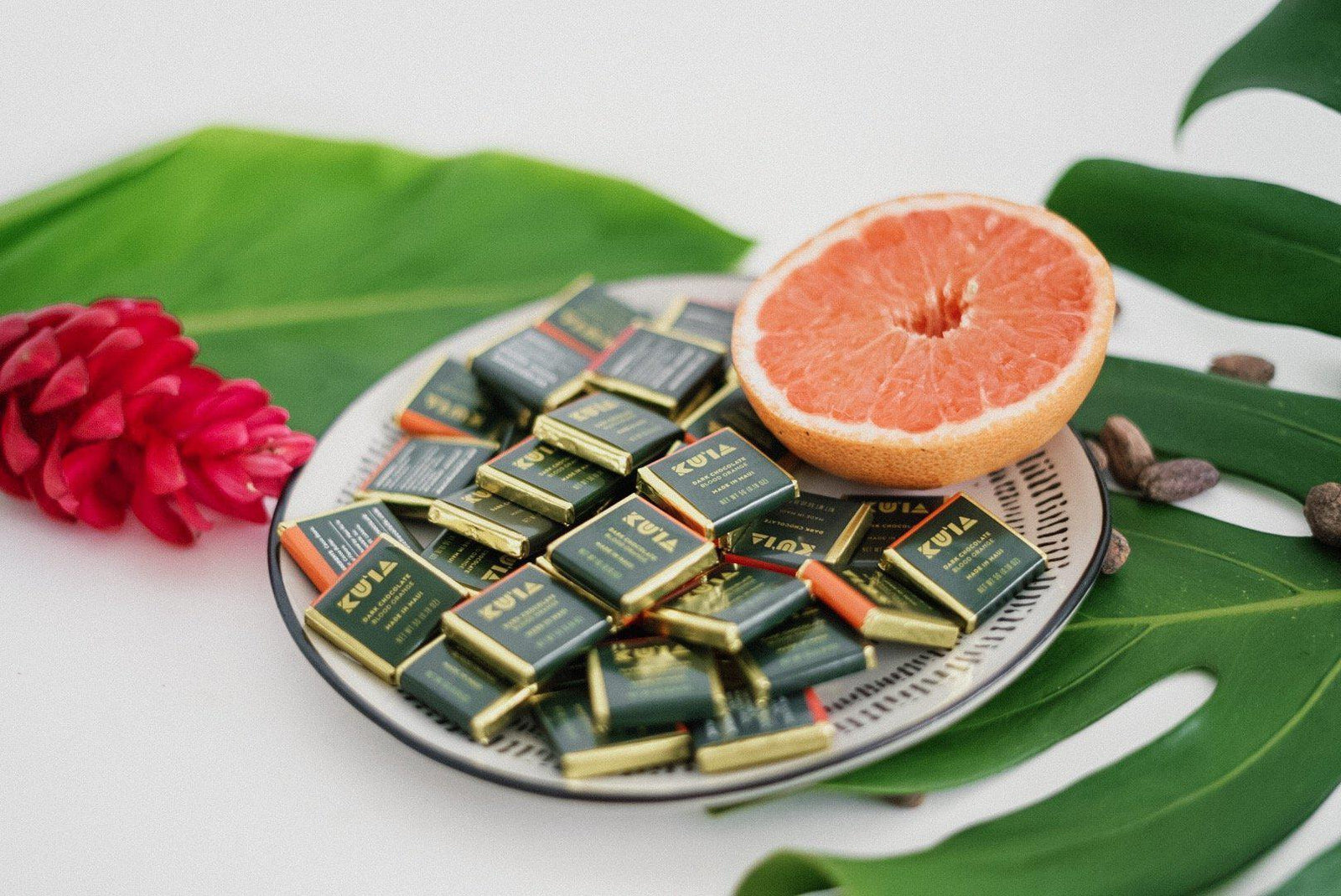
I arrive at the Ku’ia factory at 10am, and the air is alive with the rhythm of chocolate making. A big glass window reveals the inner workings of the factory. Gunars stands at the molding machine with Nainoa—they both wear hairnets and dark green aprons with golden Ku’ia letters embroidered on the chest. Krishna opens the door for me and hands me a hairnet as I enter. Gunars waves hello and returns his focus to the molding machine with Nainoa. The hum of the machines is just loud enough to make eavesdropping impossible, and I raise my voice slightly when I ask Krishna to give me a tour of the factory.
The factory is a world of white—clean white walls, white floors—populated by stainless steel surfaces with accents of Ku’ia signature green. The machines are comfortably spaced apart, and I feel like I’m in a science lab.
The cacao beans arrive in lined burlap sacks and go straight to the sorting room. In addition to bags from Ku’ia’s own farm in Lahaina, I see bags from Costa Esmeraldas in Ecuador, a farm that was just awarded the prestigious Cocoa of Excellence at the Salon du Chocolat in Paris.

Dark Chocolate Drops alongside Costa Esmeraldas Beans - Photo : Nainoa Moore
When the bags are opened, the beans are sorted by hand to pull out anything that is not a perfect cacao bean—such as pebbles, twigs, and broken beans. Because Ku’ia’s own farm has several varietals, the Ku’ia beans go to a sifting machine that sorts cacao beans according to size. Costa Esmeraldas, on the other hand, produces a single variety with a consistent bean size, making sifting unnecessary. High quality chocolate starts with consistent raw materials, allowing a scientific precision across the entire process.
A vacuum system sucks 70kg of evenly sized beans into a large rotating metal drum—positioned so the long side is horizontal. A propane burner heats the drum from below and the drum spins. During each rotation, fins on the inside of the drum toss the beans—think of the inside of a clothes drying machine—so that all the beans are the same temperature. This process runs for about 30 minutes and at a maximum temperature of 250 degrees F.
Once the beans have cooled, they are rolled over to a machine called a winnower whose job is to crack the beans and separate the husk (the shell outside) from the nib (the nutty inside). The husks go to a compost pile, and the nibs continue on their journey towards becoming chocolate.
The nibs are poured into a pre-refiner that crushes them between two granite rollers. What comes out is flaky and speckled with many hues of brown—and it smells strongly of chocolate. The trade term for this smashed up cacao is “cocoa mass.”
The tubs of cocoa mass are wheeled to the mill room, which houses two identical ball mills. The production line splits, and from here on, there are two machines at each station—one for dark chocolate and one for dark milk chocolate. A ball mill is a big cylinder filled with thousands of small stainless steel spheres, each just smaller than a marble. The cocoa mass goes into the machines along with sugar and cacao butter—and milk powder for the dark milk chocolate machine.
When the machine is turned on, the insides spin at a speed of 60 rotations per minute and the metal balls fly around smashing the cacao and the sugar particles—mixing everything together and turning the raw ingredients into what can finally be called chocolate. Chocolate is an emulsion, which means that the solid particles of cacao solids and sugar crystals (and milk powder for the dark milk chocolate) are all suspended in the cacao butter. Nothing is soluble, so the sugar crystals do not dissolve in the cacao butter, and neither do the cacao solids.
|
The goal is to get the solid particles between 14 and 16 microns in size. For reference, a dime is about 1000 microns thick, and a strand of human hair is generally between 50 and 80 microns wide. If the particles are too small, the chocolate will be thick, fudgy, and difficult on the machines. If the particles are bigger than 16 microns, the chocolate will have a gritty mouthfeel. In the sweet spot, the chocolate feels like a liquid on the tongue, even though it is actually a solid. After milling, the chocolate is pumped into a 500-kg capacity conche, a machine that stirs, heats, and aerates the chocolate continuously for 24 hours to smooth both the taste and texture. This balances the distribution of the cacao and sugar and ensures that the cacao particles are round and evenly covered in cacao butter. After conching, the chocolate goes to the tempering machines. Tempering is a process of heating, cooling, and reheating the chocolate to seed crystals within the chocolate. Tempered chocolate is glossy and breaks with a defined snap. Before tempering, the crystals in the chocolate are very disordered—think of them like a bunch of branches thrown in a pile. The chocolate is heated to a high enough temperature that all the crystals break down. Then the chocolate is cooled to the temperature that only type 5 crystals form—this means that the chocolate exists in a much more ordered lattice. The tempered chocolate is then heated a little bit more, but not enough to break down the crystals, and pumped into the molding machine. Maintaining the right temperature is key because if the chocolate is too hot, it will move out of temper, breaking up all those beautiful type 5 crystals, but if the chocolate is not hot enough, it will be too thick for the machines and will not distribute evenly in the mold. The machine pumps the liquid chocolate into plastic molds and sends them down a conveyor belt to the wrapping room.
Dark Blood Orange Chocolate Pieces - Photo: Nainoa Moore At the other end of the conveyor belt, Dan and Gunars crack the now-solid chocolate squares out of the mold by slapping each mold on the table. They inspect the chocolate for any imperfections—any piece that is not perfect is placed in a pile that will be melted down and remolded. The flawless squares are loaded into the wrapping machine before being spat out, perfectly wrapped and ready to eat. After the tour, I go upstairs to the Ku’ia Event Pavilion on the second floor, I look out across the ‘Au’au channel as clouds gather on the slopes of Lana’i, and I enjoy a square of dark chocolate, and now you can too at mauichocolate.com. |






Rosalind Nicklin
February 06, 2020
My Husband Chuck and I have seen the progress of Gunar and JoRene Valkir’s vision of a Chocolate Factory come true since visiting from the beginning when we toured what was a smaller farm when the first cacao plants were there. Such a dedication and hard work produced this amazing farm and now a Lahaina Factory! We can’t wait to visit in February again for Whale Tales and see it soon! Congratulations!